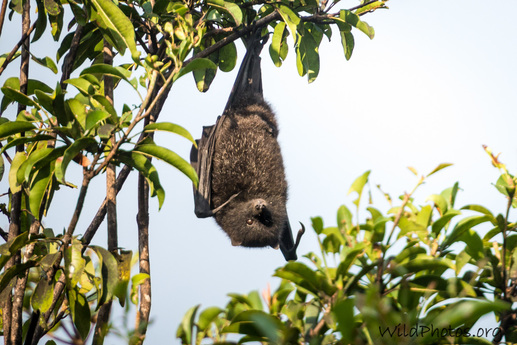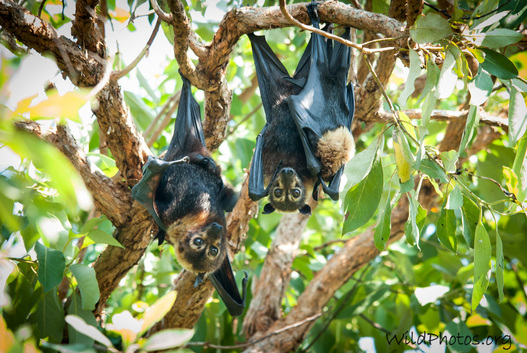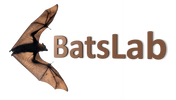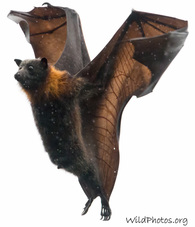UNDER CONSTRUCTION..
Brief History of Megabats
|
There are over 4,000 mammal species in the world and almost one in four of them is a bat. All bats belong to the order Chiroptera. This order includes two major sub-orders, the Microchiroptera, or true bats, currently comprising 782 species, and the Megachiroptera, comprising 175 species (Neuweiler, 2000).
The Megachiroptera (consisting of a single family, the Pteropodidae or Old World fruit bats or ‘flying-foxes’) are found throughout the Old World tropics and range from Africa, the eastern Mediterranean, Madagascar and the Indian Ocean islands in the west, across mainland southern Asia, throughout the islands of the western Pacific from the Ryukyu Archipelago and Ogasawara-Shato in the north, to coastal eastern Australia, New Caledonia and the Loyalty Islands in the south, and east to Fiji, Tonga, Samoa and the Cook Islands (Figure 1) (Mickleburgh et al., 1992). They are especially diverse in south-eastern Asia and Indo-Australia (Hall & Richards, 2000; Mickleburgh et al., 1992). |
Species profiles: |
All megachiropterans are nocturnal with the notable exception of Pteropus samoensis (e.g. Brooke, 2001). Echolocation is, with a few exceptions (i.e. some Rousettus and perhaps Epomophorus species) unknown in the Megachiroptera, and members of the group largely depend on their large eyes specialized for night vision. Many species are sexually dimorphic. Differences between the sexes include the larger body size of males (most species), males having larger canines (many species), and males with conspicuous skin glands (a few species) (Hill & Smith, 1984; Nowak & Walker, 1994). Sexual differences are extreme in one species, H. monstrosus, in which males have very large pharangeal sacs that extend into the chest and a huge larynx (used in producing a loud "honk" that is part of a sexual display) (e.g. Bradbury, 1977).
All pteropodids are frugivorous or nectarivorous (Mickleburgh et al., 1992). Pteropodids are important pollinators and dispersers of tropical trees, many of which are adapted to attract bats and make their pollination/dispersal activities more efficient (Marshall, 1985). In some instances pteropodids may also cause significant damage to orchards. The larger species are sometimes hunted for their meat.
All pteropodids are frugivorous or nectarivorous (Mickleburgh et al., 1992). Pteropodids are important pollinators and dispersers of tropical trees, many of which are adapted to attract bats and make their pollination/dispersal activities more efficient (Marshall, 1985). In some instances pteropodids may also cause significant damage to orchards. The larger species are sometimes hunted for their meat.
Genus Pteropus
 Christmas Island flying-fox, Pteropus melanotus
Christmas Island flying-fox, Pteropus melanotus
Megachiroptera of the genus Pteropus are the largest bats in the world, ranging in adult weight from 250 to 1000 g and have a wingspan of up to 1.7 metres. The Pteropus genus has currently 57 recognised species (Mickleburgh et al., 1992). Pteropus is primarily an island taxon, with 55 species having some or all of their distribution on islands. In this genus levels of endemism are extremely high, with 35 species confined to single islands or small island groups. Only nine species are found in continental areas (five in Asia and four in Australia), and only two (P. lylei and P. poliocephalus) are restricted to continents (Mickleburgh et al., 1992).
All Pteropus species are exclusively phytophagus, feeding on floral resources (primarily nectar and pollen), fruits, leaves, bark and seeds (Marshall, 1985). Diet trees for most species comprise canopy and sub-canopy rainforest species, although Pteropus also feed in mangrove, swamp and temperate forest vegetation (Marshall, 1983).
The distributional characteristic and dietary limitations make Pteropus populations vulnerable to agricultural clearing of forests, harvesting of animals for human consumption, and programs for culling animals on crops (Wilson & Graham, 1992 and references therein). As a result, the current conservation status of manyPteropus species is not secure.
The priority grading for species action assigned by the International Union for the Conservation of Nature and Natural Resources (IUCN) (Baillie & Groombridge, 1996) assigns species to categories according to their danger of extinction. In 2004 (IUCN, 2004), five species were classed as extinct (EX), seven species were classed as critically endangered (CR), three species were classed as endangered (EN), sixteen species were classed as vulnerable (VU), three species were classed as lower risk (LR), and of two species not enough was known to determine their conservation status (DD). The remaining species were classed as Not Evaluated (NE) because they have not been assessed against these criteria.
Pteropus species have a slow life cycle characterized by low fecundity and a long life-span (e.g. McIlwee & Martin, 2002). Species that possess slow life cycles are likely to contain a higher proportion of old, experienced individuals than short-lived species, providing scope for intricate forms of social organisation (e.g. Calder, 1983).
All Pteropus species are exclusively phytophagus, feeding on floral resources (primarily nectar and pollen), fruits, leaves, bark and seeds (Marshall, 1985). Diet trees for most species comprise canopy and sub-canopy rainforest species, although Pteropus also feed in mangrove, swamp and temperate forest vegetation (Marshall, 1983).
The distributional characteristic and dietary limitations make Pteropus populations vulnerable to agricultural clearing of forests, harvesting of animals for human consumption, and programs for culling animals on crops (Wilson & Graham, 1992 and references therein). As a result, the current conservation status of manyPteropus species is not secure.
The priority grading for species action assigned by the International Union for the Conservation of Nature and Natural Resources (IUCN) (Baillie & Groombridge, 1996) assigns species to categories according to their danger of extinction. In 2004 (IUCN, 2004), five species were classed as extinct (EX), seven species were classed as critically endangered (CR), three species were classed as endangered (EN), sixteen species were classed as vulnerable (VU), three species were classed as lower risk (LR), and of two species not enough was known to determine their conservation status (DD). The remaining species were classed as Not Evaluated (NE) because they have not been assessed against these criteria.
Pteropus species have a slow life cycle characterized by low fecundity and a long life-span (e.g. McIlwee & Martin, 2002). Species that possess slow life cycles are likely to contain a higher proportion of old, experienced individuals than short-lived species, providing scope for intricate forms of social organisation (e.g. Calder, 1983).
Pteropus species in Australia
 Spectacles flying-fox, Pteropus conspicillatus
Spectacles flying-fox, Pteropus conspicillatus
The Australian mainland is home to 81 species of Chiroptera. Of these, four species belong to the genus Pteropus: the Little Red Flying-Fox, Pteropus scapulatus, the Spectacled Flying-Fox, P. conspicillatus, the Black Flying-Fox, P. alecto and the grey-headed flying-fox, P. poliocephalus (Hall, 1987; Hall & Richards, 2000).
With the exception of the distribution of P. scapulatus that extends deep into Australia’s hot interior, the distributions of Australia’s mainland Pteropus species are predominantly coastal (Figure 2; Churchill, 1998; Hall & Richards, 2000; Markus, 2000). P. conspicillatus is limited to the wet tropical coast of Far North Queensland, north of Townsville to the tip of Cape York Peninsula (Hall & Richards, 2000). P. alecto’s northern distribution extends into Papua New Guinea and Indonesia (Mickleburgh et al., 1992). In Australia the range of P. alecto is approximately 1.6 million km2 (Webb & Tidemann, 1996). In the west its southern limit is currently near Carnarvon (Western Australia) (Hall & Richards, 2000); in the east it now extends as far as Melbourne (Victoria). South of Rockhampton (Queensland), P. alecto shares its range with P. poliocephalus . P. poliocephalus is endemic to the south-eastern forested areas of Australia, principally east of the Great Dividing Range. It extends as far south as Melbourne (Victoria) (Hall & Richards, 2000; Ratcliffe, 1931) where it occupies more extreme latitudes than any other megachiropteran (e.g. Mickleburgh et al., 1992; Reardon, 1999; Tidemann, 1999), and has recently established an outlying population in Adelaide (personal observations).
The majority of field-based biological research on Australian Pteropus species to date has focused on foraging patterns and its implications for seed dispersal and pollination of native forests (e.g. Eby, 1991; Palmer & Woinarski, 1999); however, very little is known about Pteropus behaviour in colonies and at feeding sites, a problem commonly encountered in this ecologically important group of animals (Mickleburgh et al., 1992; see also Wilson & Graham, 1992).
P. poliocephalus is perhaps the best studied species in the Pteropus genus, and base-line information on its general ecology (see Eby, 1996; McWilliam, 1986; Nelson, 1965b; Parry-Jones & Augee, 1991; Ratcliffe, 1932) and reproductive biology (Martin, 1998; Martin et al., 1993; Martin et al., 1995; Martin et al., 1987; O'Brien et al., 2003) have largely been established. However, even for this species information on behaviour in colonies and at feeding sites is largely anecdotal and the only published study on the social organisation of P. poliocephalus dates to the 1960’s (Nelson, 1965a).
With the exception of the distribution of P. scapulatus that extends deep into Australia’s hot interior, the distributions of Australia’s mainland Pteropus species are predominantly coastal (Figure 2; Churchill, 1998; Hall & Richards, 2000; Markus, 2000). P. conspicillatus is limited to the wet tropical coast of Far North Queensland, north of Townsville to the tip of Cape York Peninsula (Hall & Richards, 2000). P. alecto’s northern distribution extends into Papua New Guinea and Indonesia (Mickleburgh et al., 1992). In Australia the range of P. alecto is approximately 1.6 million km2 (Webb & Tidemann, 1996). In the west its southern limit is currently near Carnarvon (Western Australia) (Hall & Richards, 2000); in the east it now extends as far as Melbourne (Victoria). South of Rockhampton (Queensland), P. alecto shares its range with P. poliocephalus . P. poliocephalus is endemic to the south-eastern forested areas of Australia, principally east of the Great Dividing Range. It extends as far south as Melbourne (Victoria) (Hall & Richards, 2000; Ratcliffe, 1931) where it occupies more extreme latitudes than any other megachiropteran (e.g. Mickleburgh et al., 1992; Reardon, 1999; Tidemann, 1999), and has recently established an outlying population in Adelaide (personal observations).
The majority of field-based biological research on Australian Pteropus species to date has focused on foraging patterns and its implications for seed dispersal and pollination of native forests (e.g. Eby, 1991; Palmer & Woinarski, 1999); however, very little is known about Pteropus behaviour in colonies and at feeding sites, a problem commonly encountered in this ecologically important group of animals (Mickleburgh et al., 1992; see also Wilson & Graham, 1992).
P. poliocephalus is perhaps the best studied species in the Pteropus genus, and base-line information on its general ecology (see Eby, 1996; McWilliam, 1986; Nelson, 1965b; Parry-Jones & Augee, 1991; Ratcliffe, 1932) and reproductive biology (Martin, 1998; Martin et al., 1993; Martin et al., 1995; Martin et al., 1987; O'Brien et al., 2003) have largely been established. However, even for this species information on behaviour in colonies and at feeding sites is largely anecdotal and the only published study on the social organisation of P. poliocephalus dates to the 1960’s (Nelson, 1965a).
References
- Altringham, J.D. (1996) Bats: biology and behaviour. Oxford University Press, Oxford.
- Baillie, J.E.M. & Groombridge, B. (1996). IUCN Red List of threatened animals. International Union for the Conservation of Nature and Natural Resources, Gland, Switzerland.
- Bradbury, J.W. (1977) Lek mating behaviour in the hammer headed bat. Zeitschrift für Tierpsychologie, 54, 225-255.
- Brooke, A.P. (2001) Population status and behaviours of the Samoan flying fox (Pteropus samoensis) on Tutuila Island, American Samoa. Journal of Zoology, 254, 309-320.
- Calder, W.A.I. (1983) Body size, mortality and longevity. Journal of Theoretical Biology, 102, 135-144.
- Churchill, S. (1998) Australian bats. Reed New Holland, Sydney, NSW.
- Eby, P. (1991) Seasonal movements of grey-headed flying-foxes, Pteropus poliocephalus (Chiroptera: Pteropodidae), from two maternity camps in northern New South Wales. Wildlife Research, 18, 547-549.
- Eby, P. (1996) Interactions between the grey-headed flying-fox, Pteropus poliocephalus (Chiroptera: Pteropodidae) and its diet plants - seasonal movements and seed dispersal. Ph.D, University of New England, Armidale.
- Hall, L.S. (1987) Identification, distribution and taxonomy of Australian flying-foxes (Chiroptera: Pteropidae). Australian Mammalogy, 10, 75-79.
- Hall, L.S. & Richards, G.C. (2000) Flying foxes: fruit and blossom bats. University of New South Wales Press, Sydney.
- Hill, J.E. & Smith, J.D. (1984) Bats: a natural history. British Museum (Natural History), London.
- IUCN (2004) 2004 IUCN Red List of Threatened Species.
- Markus, N. (2000) Ecology and behaviour of the black flying fox Pteropus alecto in an urban environment. Ph.D., University of Queensland, St. Lucia, Qld.,.
- Marshall, A.G. (1983) Bats, flowers and fruit: evolutionary relationships in the Old World. Journal of the Linnean Society, 20, 115-135.
- Marshall, A.G. (1985) Old world phytophagus bats (Megachiroptera) and their food plants: a survey. Zoological Journal of the Linnean Society, 83, 351-369.
- Martin, L. (1998) Posture and pauses during parturition in flying-foxes (Genus Pteropus, suborder Megachiroptera). Australian Zoologist, 30, 437-442.
- Martin, L., Kennedy, J.H., Little, L., & Luckhoff, H.C. (1993) The reproductive biology of Australian flying-foxes (genus Pteropus). In Ecology, evolution and behaviour of bats (ed S.M. Swift), pp. 167-186. Oxford, London.
- Martin, L., Kennedy, J.H., Little, L., Luckhoff, H.C., O'Brien, G.M., Pow, C.S.T., Towers, P.A., Waldon, A.K., & Wang, D.Y. (1995) The reproductive biology of Australian flying-foxes (genus Pteropus). In Symposia
- of the Zoological Society of London, No 67. pp. 167-184. Clarendon Press, Oxford, UK.
- Martin, L., Towers, P.A., McGuckin, M.A., Little, L., Luckhoff, H., & Blackshaw, A.W. (1987) Reproductive biology of flying foxes (Chiroptera: Pteropodidae). Australian Mammalogy, 10, 115-118.
- McIlwee, A.P. & Martin, L. (2002) On the intrinsic capacity for increase of Australian flying-foxes (Pteropusspp., Megachiroptera). Australian Zoologist, 32, 76-100.
- McWilliam, A.N. (1986) The feeding ecology of Pteropus in northern New South Wales, Australia. Myotis, 23, 201-208.
- Mickleburgh, S.P., Hutson, A.M., & Racey, P.A. (1992) Old world fruit bats: an action plan for their conservation. I. U. C. N/S. S. C., Gland, Switserland.
- Nelson, J.E.W. (1965a) Behavior of Australian Pteropodidae (Megachiroptera). Animal Behaviour, 13, 544-557.
- Nelson, J.E.W. (1965b) Movements of Australian flying foxes (Pteropodidae: Megachiroptera). Australian Journal of Zoology, 13, 53-73.
- Neuweiler, G. (2000) The biology of bats. Oxford University Press, New York; Oxford.
- Nowak, R.M. & Walker, E.P. (1994) Walker's bats of the world. Johns Hopkins University Press, Baltimore ; London.
- O'Brien, G.M., McFarlane, J.R., & Kearney, P.J. (2003) Pituitary content of luteinizing hormone reveals species differences in the reproductive synchrony between males and females in Australian flying-foxes (genus Pteropus). Reproduction, fertility, and development, 15, 255-261.
- Palmer, C. & Woinarski, J.C.Z. (1999) Seasonal roosts and foraging movements of the black flying fox (Pteropus alecto) in the Northern Territory: resource tracking in a landscape mosaic. Wildlife Research, 26, 823-838.
- Parry-Jones, K. & Augee, M.L. (1991) Food Selection by Grey-Headed Flying Foxes (Pteropus poliocephalus) occupying a summer colony site near Gosford, New-South-Wales. Wildlife Research, 111-124.
- Ratcliffe, F. (1931) The flying fox (Pteropus) in Australia. H.J. Green government printer, Melbourne.
- Ratcliffe, F. (1932) Notes on the fruit bats (Pteropus spp.) of Australia. The Journal of Animal Ecology, 1, 32-57.
- Reardon, T. (1999) Taxonomy and selection of taxa. In The action plan for Australian bats. (eds A. Duncan, G.B. Baker & N. Montgommery), pp. 6-14. Environment Australia, Canberra.
- Tidemann, C.R. (1999) Biology and management of the grey-headed flying-fox, Pteropus poliocephalus. Acta Chiropterologica, 1, 151-164.
- Webb, N.J. & Tidemann, C.R. (1996) Mobility of Australian flying foxes. Pteropus spp (Megachiroptera): evidence from genetic variation. Proceedings of the Royal Society of London, series B, 497-502.
- Wilson, D.E. & Graham, G.L. (1992) Pacific Island Flying-Foxes. In Proceedings of an International Conservation Conference (eds D.E. Wilson & G.L. Graham). US Department of the Interior Biological report No 90.


